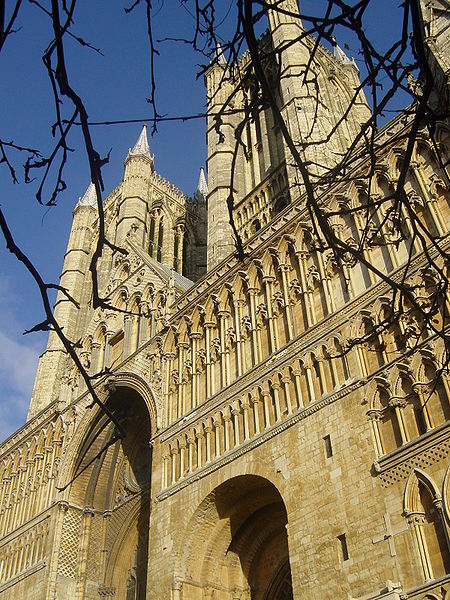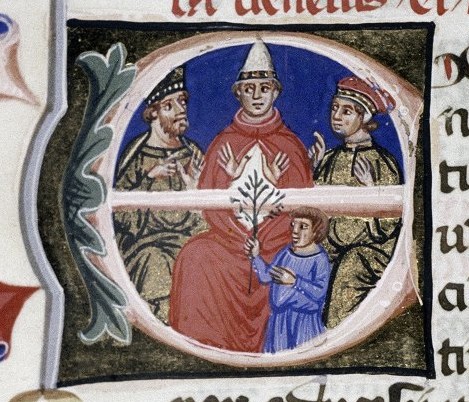 |
| Henry II |
Geoffrey Plantagenet was born in 1152; his mother is
believed to be a prostitute named Ykenai, Walter Map[i] described her as;
His father
was Henry II, King of England who married
Eleanor of Aquitaine on 18th May 1152. It is likely that Geoffrey
was conceived before the marriage. Henry was an enthusiastic lover of women and
Geoffrey was his oldest child.
Once Henry
had been crowned king on 19th December 1154 Ykenia presented her son
at court. Against his councillors advice Henry acknowledged Geoffrey as his
child; Geoffrey was circa two years old at the time. Henry was devoted to his
son; similarly Geoffrey loved his father who had him brought up in the royal
household with his half-brothers and sisters. Whatever his father thought about
Geoffrey, unsurprisingly Queen Eleanor showed him no affection.
The eldest
of Henry’s legitimate son’s was William born in 1153[iv],
followed in 1155 by Prince Henry[v], Matilda[vi] in 1156, Richard in 1157, Geoffrey of Brittany[vii] in 1158,. There was then a break
until 1162 when Eleanor[viii] was born, Joan[ix] followed three years later in 1165.
Henry and Eleanor’s final child was John, born in 1166.
The Cleric and War
 |
| Lincoln Cathedral |
When he was
older Geoffrey was sent to school in Nottingham, where he studied canon law. Geoffrey may have done some teaching at the University of Paris during the early 1170s. While a ‘mere boy’ Geoffrey entered into minor orders and was appointed Archdeacon of Lincoln in September 1171 and bishop-elect by 1173; in April Henry persuaded the canons of Lincoln cathedral to elect Geoffrey. He also held a prebendary in the diocese of London, although he does not appear have performed any of
the duties normally required.
In the
autumn of 1173 Pope Alexander III refused to confirm Geoffrey’s
election as bishop, his main objections being Geoffrey’s youth and
illegitimacy. The refusal required a visit to Rome on Geoffrey’s part. The trip was delayed by family problems.
By 1173 the
relationship between Henry and Eleanor had broken down. Eleanor, now 51, may
have decided to flex her muscles. Similarly her sons, kept on a leash by their
father, were itching to break free from their father’s domination. Egged on by
their mother the three eldest boys Henry[x]
who demanded control of Normandy, England or Anjou,, Richard and Geoffrey of Brittany raced away from Henry’s court at Chinon. Henry had been forewarned by Raymond of Toulouse[xi], at Chinon to acknowledge Henry’s
overlordship;
‘I advise you, King, to
beware of your wife and sons.’[xii]
 |
| Louis VII denier |
They arrived
in Paris to join the court of their father’s arch enemy, Louis VII of France[xiii]
who was only too keen to avenge any number of insults[xiv].
Eleanor, disguised as a man, was picked up as she tried to leave the court and
was taken back to her husband[xv].
Four of Henry’s earls, one of them being Earl Robert de Beaumont of Leicester, backed the rebellion along with a number of other leading landowners. William the Lion, king of Scotland, declared for the rebels, so Henry
was forced to fight on a number of fronts.
Supporting the King
Over the
winter Henry and the loyalists were able to hold their own, but gradually the balance
of control toppled in Henry’s direction. Much of the fighting took place in
Normandy. In England it was the Midlands that was crucial for both rebels and
loyalists alike. The king’s deputy and Justiciar Richard de Lucy was to be key in keeping control of
the kingdom for Henry.
 |
| Carlisle castle |
At Easter
1174 the English rebels made cause with William the Lion who invaded, besieging
Carlisle castle. William of Newburgh commented that;
‘There were only a few barons
at that time in England who were not wavering in their allegiance to the king
and ready to defect.’’[xvi]
The rebels
in the Midlands attacked and raided Northampton and took control of Nottingham and with it Richard de Lucy. Geoffrey exhorted the people of
Lincoln to follow him north and crush the rebels.
 |
| Motte at Topcliffe |
Geoffrey
besieged one of the rebel leaders, Roger de Mowbray, at his castle of Kinardferry on the Isle of Axholme. Geoffrey captured Roger, razed the castle to the ground and
marched north. There he took another of Mowbray’s castles at Kirby Malzeard and then a third castle at Thirsk was neutralised by the erection of a fort at neighbouring Topcliffe.
The rebels
countered with an invasion of England, led by Count Philip of Flanders whose advance party joined up with Hugh Bigod to capture Norwich and then besieged
Huntingdon. Henry was persuaded to travel
across the channel. Immediately he left France Count Philip countermanded the
invasion and joined with Louis of France to attack Normandy. By 22nd
July 1174 the joint forces were outside Rouen.
Wrapping Up the Rebellion
.png/603px-William_I%2C_King_of_Scots_(seal_01).png) |
| William the Lion's seal |
The 22 year
old Geoffrey now took on the man who was to become his major enemy; the 49 year
old Hugh de Puiset, Bishop of Durham. Puiset had been conniving with the rebels, without
actively joining the rebellion. Geoffrey forced Puiset to pledge his future
loyalty to Henry and ordered him to stop meddling. Geoffrey then turned his
attention further north to confront William the Lion who was besieging Bowes Castle.
As
Geoffrey’s army approached Bowes William the Lion broke off the siege and
retreated towards Alnwick. A few days later William and his
men were surprised outside the castle. On 13th
July 1174 William the Lion was captured by the loyalists, led by Ranulf de Glanvill, Sherriff of Yorkshire, at the battle of Alnwick.
William’s
capture meant the collapse of the rebellion in England and Geoffrey joined his
father in Huntingdon which surrendered upon the king’s arrival. Geoffrey was
greeted with pleasure, Henry allegedly crying out;
‘Base-born indeed have my
other children shown themselves; this alone is my true son.’[xvii]
Henry then
travelled with his normal speed to Nottingham and all the English rebels journeyed
there to surrender to their liege lord. A peace in England was patched up and
Henry treated his barons with leniency.
‘So the mighty learned that
to wrest the club from the hand of Hercules was no easy task’[xviii]
Henry’s
treasurer crowed. Henry followed this victory up by confounding his enemies in
France; he was back in Normandy by 8th August, taking Geoffrey with
him, landing at Barfleur. The siege of Rouen was not
proceeding with any real despatch and when Henry arrived he attacked Louis’ wagon
train which, with a sortie
from the city itself, was sufficient to send Louis and his army packing. Louis
sued for peace in September.
A Visit to Rome
 |
| Pope Alexander III (C) |
Geoffrey journeyed
to Rome in October 1174 and was finally confirmed bishop by July 1175; the pope
acquiescing under duress. Alexander issued a papal dispensation. On 1st
August Geoffrey made a ceremonial visit to Lincoln where Adam, Bishop of St Asaph, had been covering the bishop’s
duties before Geoffrey’s confirmation. Geoffrey was sent by Henry to study at
the cathedral
school at Tours for a period
When
Geoffrey finally returned to his diocese he was more apt to attend to temporal
affairs rather than the spiritual. Geoffrey acted as a royal tax collector, gaining
a reputation as being ‘efficient and
uncompromising’, leading one contemporary to comment;
‘He was more skilful to
fleece the Lord’s sheep than to feed them.’[xix]
Geoffrey was
also a benefactor to his diocese, active in recovering diocesan estates,
encouraging scholars to work at the cathedral school and bestowing upon the
cathedral two ‘large and fine’ bells.
Bibliography
King John –
Stephen Church, MacMillan 2013
Early
Medieval England – MT Clanchy, The Folio Society 1997
Richard the
Lionheart – John Gillingham, George Weidenfeld and Nicholson 1989
The Royal
Bastards of Medieval England – Chris Given- Wilson and Alice Curteis, Barnes
& Noble Books 1995
The
Plantagenets – Dan Jones, William Collins 2012
Henry II –
WL Warren, Yale University Press 2000
King John –
WL Warren, Yale University Press 1997
Eleanor of
Aquitaine – Alison Weir, Jonathan Cape 1999
The
Plantagenets – Derek Wilson, Quercus Editions Ltd 2014
[ii]
There is a possibility that Ykenai or Akeny was more than a one-night stand as
she may have also been the parent of William
Longsword, another of Henry’s children on the wrong side of the blanket
[iii]
Eleanor of Aquitaine - Weir
[iv]
Who died age two
[v]
Crowned as Henry’s co-king in 1170; thereafter known as the Young King
[x]
Already 18 and married to a daughter of the King of France, Henry was viewed by
his father as an ‘idle, vain, charming
spendthrift’.
[xi]
At court to bow the knee to Henry
[xii]
Eleanor of Aquitaine - Weir
[xiii]
Their mother’s ex-husband
[xv]
Eleanor was kept captive for the next sixteen years
[xvi]
Henry II - Warren
[xvii]
The Royal Bastards – Given-Wilson & Curteis
[xviii]
Henry II - Warren
[xix]The
Royal Bastards – Given-Wilson & Curteis
Ykenia [or Ykenai, you have both] is not a name I have come across! which is not something I often say. Any idea where she's from? it doesn't sound French, unless it's Breton
ReplyDeleteGiven-Wilson and Curties refer to Hikenai or Ykenai as base-born (Ykenia a mis-spelling, thank you for pointing that out), with reference to information from Walter Map. Another chronicler of the time referred to her as the daughter of a knight. There seems to be no reference to where Geoffrey was born to give a clue as to where Ykenai originated.
DeleteI've run the name to earth! Ikerne is a Basque female name
ReplyDelete